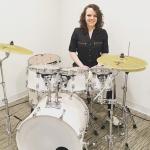Drummer’s Guide to Practice Routines

Lindsay Artkop is a professional musician and educator who teaches Drums lessons online and Percussion lessons online. Learn more on her Lessonface profile.
The most important part of growth as a musician is having great practice habits.
Consistency in your practice routine is the biggest key. It’s much better to practice for 15 minutes a day, 5 days a week, than it is to practice for any amount of hours in one day, once in a while. This is because you need to maintain your musical progress in order to continue building, otherwise you’ll spend your infrequent practice sessions frustrated that you’re not growing. Another crucial part of growing as a musician is what you actually practice. If you spend all your time jamming or repeating the few things you know, you’ll simply never grow. Your goal for every practice session should instead be to challenge yourself. Slight improvements every day are what breeds a great musician.
Here is a guide that will help you design a practice routine that works for you and your drumming goals.
1. Warm Ups
The first step in a great practice routine is warming up your body. Try doing some light exercise or running your hands under warm water. This will ensure your muscles are warm and ready to be used. Next you can stretch your arms and hands. Stretching also helps prepare your body and muscles get ready to play. Next, you can begin playing something simple like singles, doubles, or paradiddles. Take it slow and build your speed over time. Use a metronome to simultaneously work on your timing. After that, you can move on to a particular warm-up exercise that you might be working on currently. This could be something like a rudiment, snare solo, or a page from Stick Control. It’s also good to warm up your feet. You could use patterns from Stick Control between the hi hat and kick drum. Or try a snare/kick pattern around the kit such as “RLKK.” Try new exercises often to keep it fresh and ensure you’re always growing.
2. Drum Set Exercises
This next stage in your practice routine is for working on specific drum set exercises. These exercises can include things like grooves, fills, or concepts. Try a sheet of challenging grooves, fills, or a conceptual exercise from the Syncopation book by Ted Reed. Besides working on the actual content of the exercises, this is a great time to throw on a metronome, and focus on zooming in on your playing. You should have a whole list of things in your mind that you go through to improve your technique. Ask yourself questions like these:
“Am I relaxed?"
“Am I playing in time?”
“Are my rim shots consistent?”
“Do I have a good acoustic mix happening within my kit?”
This is the time to be super mindful of your playing, so you can train yourself to always perform at your best. Remember that whatever you practice, good or bad, will become the habits that you internalize.
3. Music / Songs
The end goal of course for any instrumentalist is to be able to play songs. No one is going to get up on stage and play a page out of Stick Control! All the foundational and exercise work you do leads up to having the actual chops and technique to play songs well. During this stage of your practice routine, you can do things like play along with records, transcribe solos by your favorite drummers, record yourself playing a song and listen back, or read a transcription. Try not to over or under play. As a drummer, some important things to focus on are keeping solid time, having a great feeling groove, and playing authentically to the genre and song. The goal is ultimately to practice serving the music.
4. Free Jam / Creativity
The last and most fun part of a practice routine is working on creativity. It’s last because it rewards you with some fun after all the hard work you just did. You’ll also be utilizing all the techniques from the previous stages, only now you can focus on the creativity, while your limbs and subconscious use the muscle memory you’ve been programming. Some things to focus on during this stage are experimenting with dynamics, rhythms, orchestrations, and musical phrasings. You can try things like writing a drum solo, a drum part for a song, or creating a groove. It might not sound great at first. Try to set creative goals for yourself, like creating one groove every day for a month. You’ll start to see how easy it is to write music when you do it frequently.
Remember that creativity is a muscle. You can create well if you create often.
 |
ABOUT LINDSAY
Lindsay graduated from Berklee College of Music in May 2016 with a B.A in Professional Music, and was a featured drummer in the annual commencement ceremony concert. In May 2015, Lindsay won 1st place in Hit Like a Girl, an international competition for female drummers. Judges included Kim Thompson (Beyoncé, Late Night with Seth Meyers), Venzella Joy (Beynoncé), Didi Negron (Cirque De Soleil), Hannah Welton (Prince) and more. Lindsay is now based in Los Angeles, California. She's performed with artists of Pop, Rock, Fusion and Jazz Genres at filled arenas as well as intimate venues. She also has extensive filming experience, having played drums for TV commercials, TV Show Pilots and music videos. |
Lindsay's lessons are rated five stars in 14 verified student reviews, like this one:
Well prepared instructor with very relevant material. Thanks!
-Verified Student, review from January 3, 2019




